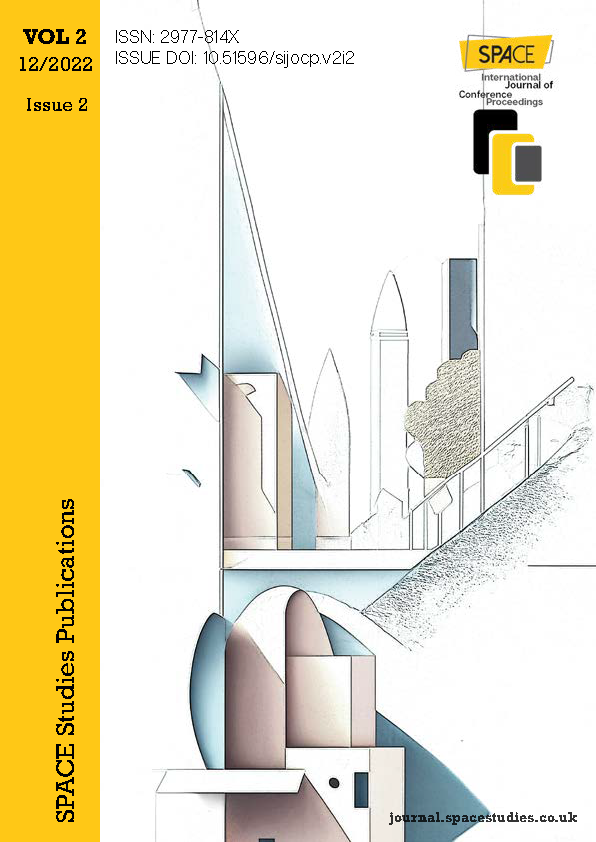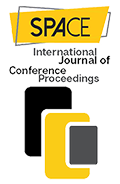The Multidimensional Exploration Methodology for Architectural Design Studio Education: An Innovative Teaching Methodology Proposal
DOI:
https://doi.org/10.51596/sijocp.v2i2.61Keywords:
architectural design studio education, challenge-based learning, design-driven innovation, digital design-thinking, human-centred design, learning theoriesAbstract
In this paper, we discuss the next phase of architectural design, and concerning the requirements of this point of view, we propose a new learning approach that includes digital-design thinking (by the approach) and design-driven innovation (as outcomes).
The paper aims to reflect an architectural understanding shaped by current global facts and developing technologies. Moreover, we discuss this understanding from the academic perspective, which is compatible with the globally evolving socio-cultural, environmental, and economic norms. Therefore, under the title, The Multidimensional Exploration Methodology, we present a new education scheme and a learning methodology that transfers this aligned view to the architectural design studio education model and trains new designers accordingly.
The learning method is developed by taking references from existing methods and blending them into each other in a way compatible with architectural design. While addressing the student as a professional, this method challenges them via real problems through challenge-based learning and adopts the new architectural understanding through the cognitive learning method. Furthermore, it aims to develop designers’ perceptions and approaches that align with the digital world through design-science research methodology within the framework of a new understanding. Consequently, it develops practical skills with the learning-by-doing model.
This new architectural concept has emerged, backed up by the power of data and shaped by users’ roles and responsibilities in the digital age. This understanding, which is not only limited to Form and Function but also consists of ‘Form + Function + Interaction’, should be covered by design schools as a progression for the human-centred design approach.
References
Akin, O. (2008). Frames of Reference in Architectural Design: Analyzing the Hyper-Acclamation (A-h-a-!). College of Fine Arts at Research Showcase, 1-20.
Alexander, C. (1965). A City is not a Tree (Vols. 50th Anniversary Edition,2015). (M. W. Mehaffy, Ed.) Sustasis Foundation, Center for Environmental Structure.
Apple Inc. (2010). Challenge Based Learning A Classroom Guide. Retrieved from https://www.challengebasedlearning.org (Last Access: 10 January 2022)
Arvola, M., & Artman, H. (2008). Studio life: The construction of digital design competence. Digital Kompetanse, 3(2), 78–96. https://doi.org/10.18261/ISSN1891-943X-2008-02-02
Beder, S. (2002). Greenwashing. International encyclopedia of environmental politics. Abingdon: Routledge.
Birgonul, Z. (2020). Innovative Approaches for Avantgarde Artifacts: Discovering the Future, Reinventing the Design-Thinking. In E. (Eds. Garip, & S. B. Garip, Methodologies for Design and Production Practices in Interior Architecture. Hershey, Pennsylvania, USA: IGI Global.
Birgonul, Z., & Carrasco, O. (2021). The adoption of multidimensional exploration methodology to the design-driven innovation and production practices in the AEC industry. JCEMI: Journal of Construction Engineering, Management & Innovation, 4(2), 92-105. https://doi.org/10.31462/jcemi.2021.02092105
Bloom, B., & Krathwohl, D. (1984). Taxonomy of Educational Objectives, Handbook 1: Cognitive Domain. (B. S. Addison, Ed.) New York: Wesley Pub. Co..
Castells, M. (1996). The Information Age: Economy, Society and Culture. Oxford: Wiley-Blackwell.
Castells, M. (2009). The Rise of the Network Society. Oxford: Wiley-Blackwell.
Colakoglu, B., & Yazar, T. (2007). An Innovative Design Education Approach: Computational Design Teaching For Architecture. METU JFA, 24(2), 159-168. http://jfa.arch.metu.edu.tr/archive/0258-5316/2007/cilt24/sayi_2/159-168.pdf
De Botton, A. (2006). Architecture of Happiness. New York, USA: Vintage Books.
Demirbas, O., & Demirkan, H. (2003). Focus on the architectural design process through learning styles. Design Studies, 24, 437–456. https://doi.org/10.1016/S0142-694X(03)00013-9
Dewey, J. (1938a). Experience and education. New York: Macmillan.
Dewey, J. (1938b). Logic: A theory of inquiry. New York: Henry Holt.
Dinham, S. (1987). An ongoing qualitative study of architecture studio teaching: analyzing teacher–student exchanges. ASHE Annual Meeting. Baltimore: US Department of Education, Educational Recources Information Center (ERIC).
Eder, W. (2005). Application of Design Methodology for Education. Proceedings of the Canadian Engineering Education Association (CEEA). Alberta: Queens University.
Gausa, M. (2015). Celebrating Architecture – Enjoying Research. In I. Bits, Implementing Advanced Knowledge (Vol. 1). Barcelona: IaaC.
Gausa, M., Guallart, V., Müller, W., & Cros, S. (2003). The Metapolis dictionary of advanced architecture: city, technology and society in the information age. (E. Krasny, Trans.) Barcelona: Actar.
Gershenfeld, N. (2012). How to make almost anything: The digital fabrication revolution. Foreign Affairs, 91(6), 43-57.
Goldschmidt, G. (2002). “One-on-One”: a pedagogic base for design instruction in the studio. Proc. Common Ground, Design Research Society International Conference (pp. 430–437). Staffordshire University Press.
Greenwald, A. G. (1968). Cognitive learning, cognitive response to persuasion, and attitude change. Psychological foundations of attitudes, 147-170.
Henver, A., March, S., Park, J., & Ram, S. (2004, March). Design Science in IS Research. MIS Quarterly, 28(1), 75-105.
Kolb, A., & Kolb, D. (2017). Learning Styles and Learning Spaces: Enhancing Experiential Learning in Higher Education. Academy of Management Learning & Education, 4(2). https://doi.org/10.5465/amle.2005.17268566
Kolb, D. (1984). Experiential learning: Experience as the source of learning and development. Englewood Cliffs, New Jersey, USA: Prentice-Hall.
Kolb, D., Boyatzis, R., & Mainemelis, C. (1999). Experiential Learning Theory: Previous Research and New Directions. (R. J. Zhang, Ed.) Perspectives on Cognitive, Learning, and Thinking Styles.
Le Corbusier. (1986). Towards a New Architecture. New York, USA: Dover Publication.
Martin, J. (1978). The Wired Society: A challenge for tomorrow. New Jersey: Prentice-Hall.
Mitchell, W., Ligget, R., & Kvan, T. (1987). The Art of Computer Graphics Programming: A Structured Introduction for Architects and Designers. New York: Van Nostrand Reinhold Company.
Negroponte, N. (1995). Being Digital. New York: Alfred A. Knopf.
Oxman, R. (1999). Educating the designerly thinker. Design Studies, 20, 105–122.
Oxman, R. (2006a). Theory and Design in the First Digital Age. Design Studies, A Special Issue on Digital Design, 27(3).
Peffers, K., Tuunanen, T., Gengler, C., Rossi, M., Hui, W., Virtanen, V., & Bragge, J. (2006). The Design Science Research Process: A Model For Producing And Presenting Information Systems Research. Destrist, 83-106.
Quayle, M. (1985). Ideabook for Teaching Design. Arizona: Mesa, AZ: PDA Publisher Corporation.
Ratti, C., & Claudel, M. (2016). The City of Tomorrow: Sensors, Networks, Hackers, and the Future of Urban Life (The Future Series. New Haven, CT: Yale University Press.
Schumacher, P. (2008a). Parametricism as Style - Parametricist Manifesto. Retrieved from Patrik Schumacher: https://www.patrikschumacher.com/Texts/Parametricism%20as%20Style.html (Last Access: 5 February 2020)
Schumacher, P. (2008b, September). Smart Work: Patrik Schumacher on the growing importance of parametrics. RIBA Journal.
Schwab, K. (2017). The Fourth Industrial Revolution. (G. S. World Economic Forum, Ed.) United Kingdom: Crown Business - Portfolio Penguin.
Shaffer, D. (2007). Learning in design. (J. J. R. A. Lesh, Ed.) Foundations for the Future In Mathematics Education, 99-126.
Smithson, A., & Smithson, P. (1986, April 13). Interview with Alison and Peter Smithson. (B. Günay, Interviewer) Ankara, Turkey: METU.
Taslı-Pektas, S., & Erkip, F. (2006). Attitudes of Design Students Toward Computer Usage in Design. International Journal of Technology and Design Education, 16, 79–95. https://doi.org/10.1007/s10798-005-3175-0
Terzidis, K. (2015). Permutation Design: Buildings, Texts, and Contexts. New York: Routledge.
Van Aken, J. (2005). Management Research as a Design Science: Articulating the Research Products of Mode 2 Knowledge Production in Management. British Journal of Management, 19–36. https://doi.org/10.1111/j.1467-8551.2005.00437.x
Van Dijk, J. (1999). The Network Society. London: Sage.
Van Dijk, J. (2012). The Network Society (3rd Edition). London: Sage.
Verganti, R. (2009). Design-driven Innovation: Changing the Rules of Competition by Radically Innovating What Things Mean. Boston, MA, USA: Harvard Business Press.
Published
How to Cite
Issue
Section
Categories
License
Copyright (c) 2022 Zeynep Birgonul, Oriol Carrasco

This work is licensed under a Creative Commons Attribution 4.0 International License.













